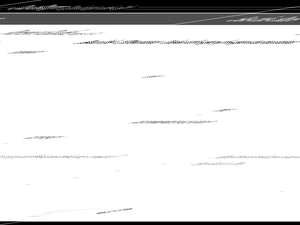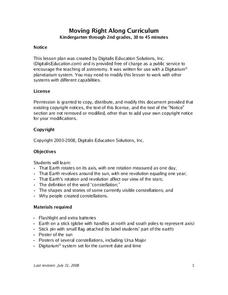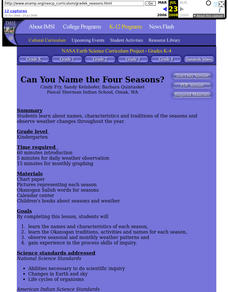Curated OER
A Galaxy Up Close
In this Sombrero Galaxy worksheet, students observe infrared images taken by the Spitzer Infrared Telescope and the Hubble Space Telescope. They answer 9 questions about the details of the images such as the radius of the stellar...
Curated OER
Calculating Black Hole Power
In this black hole worksheet, students use a given equation that relates the rate of matter falling into a black hole to the power emitted by the black hole to determine accreted mass.
Curated OER
How Hot is that Planet?
In this planet instructional activity, high schoolers read about finding the temperature of a planet using the distance to its star, its reflectivity and the luminosity of the star. Students use a given equation to determine the surface...
Curated OER
Falling into a Black Hole
In this black hole worksheet, learners solve 3 problems given the equation used to determine the speed of a falling body using its mass, the constant of gravitation and the distance it will travel.
Curated OER
Spitzer Explores a Dusty Young Star
For this stars worksheet, students read about the Spitzer space telescope and they solve 5 problems about the mass, size, and power of dust grains and interstellar mediums detected by the telescope.
Curated OER
The Volume of a Hypersphere
In this volume of a hypersphere worksheet, students solve 4 problems where they find the volume formula and calculate the volume given the dimensions of the hypersphere.
Curated OER
The Speed of Galaxy Q2125-431
In this speed of a galaxy learning exercise, students use a given equation for the speed of an object and they use the spectral lines for Hydrogen Alpha and Beta from the Seyfert galaxy to answer 6 questions. They determine the observed...
Curated OER
See the Stars
Students explore the nighttime sky. In this space science lesson, students read the book Maria's Comet and and investigate the sky using their naked eyes. Students compare the view of their naked eyes to the view of a telescope.
Curated OER
Our Changing View of the Solar System
Students identify and name the eight planets and the five dwarf planets in our solar system. In this space science lesson, students view a slideshow of the planets and label them on an included Solar System chart.
Curated OER
Observing the Sky
Students explore astronomy. In this astronomy activity, students discuss the history of the movement of celestial bodies and then communicate with other students regarding the movements that they observe in the sky nightly. Students...
Curated OER
How Hot and How Big?
Young scholars explore star color and size. In this space science lesson, students conduct various inquiry activities to explore how the color of a star affects the amount of heat produced. They also investigate how the color of stars...
Curated OER
Our Sky Clock
Students explore space science by completing a worksheet in class. In this astronomy lesson, students discuss and identify star patterns in the night sky and relate these patterns to the approximate time they appear. Students complete an...
Curated OER
An Explorative Journey Through the Solar System
Students explore space science by creating a planetary model in class. In this solar system lesson, students identify the many planets and moons that make up the solar system and decide on one entity in which to research. Students create...
Curated OER
Modeling the Big Bang and the Formation of the Universe
Sixth graders conduct an experiment to understand the Big Bang Theory. In this Big Bang Theory instructional activity, 6th graders will observe a balloon with confetti popping to emulate and analyze information related tot he Big Bang...
Curated OER
Mathematics at the Frontier of Astronomy
Students explore the different types of measurements used in astronomy. In this space science lesson, students explain the relationship between planets' orbits and distance from the sun using Kepler's Laws. They discuss how math aides in...
Curated OER
Earth's Rotation
Pupils explore the Earth and its rotation. Volunteers model the sun-Earth system to demonstrate that the Earth rotates around the sun. In groups, students simulate "traveling" around the sun and discuss when it is night and day.
Curated OER
What's Your Sign? The Science Behind The Zodiac
Students investigate the concepts dealing with the motions of celestial objects, the ancient origins of the Zodiac and the science behind the Zodiac.
Curated OER
Life Cycle Of Stars
Learners investigate the concept of stars and how they go through a life cycle. They take part in class discussion with the help of dialogue provided in the lesson plan. Students also view a powerpoint presentation for visual learners.
Curated OER
Too Bright at Night?
Students explore the consequences of light pollution. They consider benefits and drawbacks of technology in order to acquire informed attitudes on the various technologies and their social, cultural, economic, and ecological consequences. .
Curated OER
Can You Name the Four Seasons?
Students explore names, characteristics and traditions of the seasons and observe weather changes throughout the year.
Curated OER
Adapting to Seasonal Changes in the Environment
Fourth graders discuss how plants and animals, including humans, adapt to climate and seasonal changes. They research the Colville people, and create dioramas that represent life during different seasons for Colville people.
Curated OER
Nuclear Power Gets A Boost
Students examine nuclear plants and how they use fission reactions to generate electricity, compare fusion reactions to fission, and read about technology that may soon allow fusion to become practical for producing nuclear power...
Curated OER
TE Lesson: Navigating at the Speed of Satellites
Middle schoolers study the basic concepts of the Global Positioning System and how it increases the accuracy of navigation. They examine trilateration and how the speed of light is used to calculate distances.
Curated OER
The Earth's Magnetic Field
Students explain how the earth's magnetic field works and looks. They create
their own free-floating compass using the everyday materials. After constructing their compass, they test it and determine north.
Other popular searches
- Stars and Constellations
- Patterns of Constellations
- Star Constellations
- Greek Constellations
- Constellations Activity
- Solar System Constellations
- Constellations of the Zodiac
- Constellations Science
- Constellations Space
- Stars, Constellations
- Space and Constellations
- Constellations Word Search

























